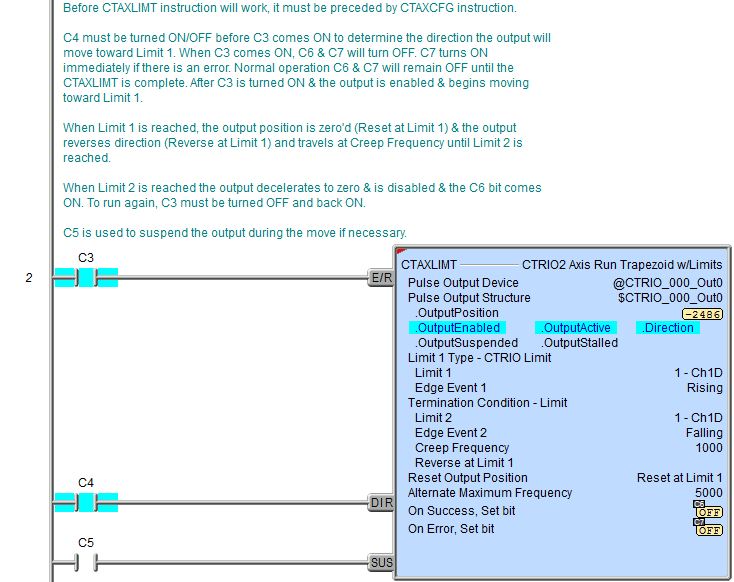Topic: DMD0523
CTAXLIMT - CTRIO2 Axis Run Trapezoid with Limits
This instruction can only be used with the CTRIO2 module.
The CTRIO2 Axis Run Trapezoid with Limits (CTAXLIMT) instruction is used to define and initiate a single move referenced to a limit, typically a limit switch connected to an input of the CTRIO2. This instruction is useful for creating a homing routine or for registration. The position move is specified in terms of Limits, not absolute or relative position values. Limits can be inputs that are hard wired to the CTRIO2 module - this requires the CTRIO2 module be configured to have one or more of its inputs as Limits, or they can be bit locations. The moves will execute using the parameters defined by a previously executed Axis Configuration (CTAXCFG) instruction.

Parameters:
Note: Use the F9 key or click the 'three dot box' at the right edge of the parameter field to open the Default Element Selection Tool (the Element Picker or the Element Browser) or use the Down-Arrow key (Auto-Complete) on any parameter field to see a complete list of the memory locations that are valid for that parameter of the instruction.
Pulse Output Device - selects which preconfigured CTRIO Pulse Output device to use. Before this instruction can select a Pulse Output device, a CTRIO Device must be configured with at least one of its output channels setup for Pulse / Direction or CW / CCW pulse output mode.
no devices available - indicates that there are no CTRIO Pulse Output devices that have been configured that can perform this instruction.
create module - will open the Create New Module Configuration dialog where a CTRIO Module can be created and then a CTRIO Pulse Output device can then be configured.
Pulse Output Structure - this field displays the name of the Pulse Output Structure that will be used by this instruction. This structure was created when the CTRIO module was configured during the Module Configuration phase.
Limit 1 Type - this option defines the first Limit.
-
CTRIO Limit - select this option to use a Limit that is hard wired to the CTRIO2.
Limit 1 - the Limit is one of the preconfigured CTRIO2 Limits, select from: 0 - Ch1C, 1 - Ch1D, 2 - Ch2C, 3 - Ch2D.
Edge Event 1 - select which edge of the Limit input signal to trigger from: Rising - when the input toggles from OFF to ON. Falling - when the input toggles from ON to OFF. Rising or Falling - when either the input toggles OFF to ON or ON to OFF.
-
PLC Bit - select this option to use a BIT location as the Limit. This can be any readable bit location.
Termination Condition - this option defines the action to take once the Limit is reached.
-
Position - select this option to move to a position location.
Offset from Limit 1 - enter the position location to move to once the limit is reached. This can be any positive or negative constant value, or any readable numeric location. A positive value will move forward (clockwise) and a negative value will move reverse (counter-clockwise).
-
Limit - select this option to use a Limit that is hard wired to the CTRIO2.
Limit 2 - the Limit is one of the preconfigured CTRIO2 Limits, select from: 0 - Ch1C, 1 - Ch1D, 2 - Ch2C, 3 - Ch2D.
Edge Event 2 - select which edge of the Limit input signal to trigger from: Rising - when the input toggles from OFF to ON. Falling - when the input toggles from ON to OFF. Rising or Falling - when either the input toggles OFF to ON or ON to OFF.
Creep Frequency - specifies the pulse output frequency to use during the move from Limit 1 to Termination Condition. The minimum frequency is 20Hz, so any value between 0 and 20 will result in a 20Hz output signal.
Reverse at Limit 1 ( only available with the Termination Condition is Limit) - enable this to reverse the direction at Limit 1.
Reset Output Position - this option defines the action to take after the termination Condition is completed:
- Do Not Reset
- do not reset the current position value (.OutputPosition
will retain its current value).
- Reset at Limit 1 - the
current Pulse Output position value will be reset to 0 (.OutputPosition
= 0) when Limit 1 is reached, but will retain any position value changes
incurred during the Termination Condition
phase.
- Reset at Completion - the
current Pulse Output position value will be reset to 0 (.OutputPosition
= 0) after the Termination Condition
phase is completed.
Alternate Maximum Frequency - enable this option to specify the frequency (in pulses per second) that the pulse output will ramp towards that is different from what is specified in the Axis Configuration (CTAXCFG) instruction. This can be any positive constant value or any readable numeric location. The value is only read when the E/R input initially comes ON.
The On Success and On Error parameters specify what action to perform when this instruction completes. You do not have to use the same type of selection for both On Success and On Error.
If the Set Bit selection is used for either On Success or On Error, the specified BIT location will be SET OFF when the instruction is first enabled and will remain OFF until the instruction completes. Once complete, the appropriate Success or Error bit location ON. The specified Bit location is enabled with a SET (Latch) operation meaning that it will remain ON even if the input logic for the instruction goes OFF.
If the JMP to Stage selection is used for either On Success or On Error the target Stage must be in the same Program code-block as this instruction, you cannot specify a target Stage that exists in a different Program code-block. When the operation finishes, the target Stage will be enabled the same way as a standalone Jump to Stage (JMP) instruction would do it. The JMP to Stage option will only be available if this instruction is placed in a Program code-block.
On Success selects which of the following actions to perform if the operation is successful:
- Enable SET Bit then specify any writable bit location.
- Enable JMP to Stage then specify any
Stage number from S0 to S127 in the current Program code-block.
On Error selects which of
the following actions to perform if the operation is unsuccessful:
- Enable SET Bit then specify writable bit location.
- Enable JMP to Stage then specify any Stage number from S0 to S127 in the current Program code-block.
If either the On Success or On Error selections are set to JMP to Stage, Automatically create the SG box for any NEW stage number will be enabled which will automatically create any target stage that does not already exist.
- Below this rung will create the new target stage on a new rung following this instruction.
- At end of code-block will create the new target stage as the last rung of this Program.
Note: any time the On Error condition occurs, the CTRIO generates an Error Code that can be read in the <Module Name>.ErrorCode (Module Name is the name assigned to the CTRIO in the Module Configuration). The List of Error Code values (in decimal) follows:
Instruction Inputs:
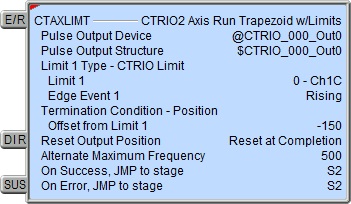
The first input (E/R) in the Enable / Reset input. When this input logic is ON the specified Pulse Output will be enabled (.OutputEnabled = ON) and the Pulse Output Device will begin to move in the direction specified by the DIR input toward Limit 1.
The second input is the Direction (DIR) input. The state of this input determines the direction of the position move. If this input logic is OFF when the E/R input logic comes ON, a clockwise (positive) move is performed. If this logic is ON when the E/R input logic comes ON, a counter-clockwise (negative) move is performed.
The third input (SUS) is the Suspend input.
When this input logic transitions ON, the
CTRIO2 will ramp down to zero using the Deceleration
Rate specified in the Axis Configuration (CTAXCFG) instruction.
No additional pulses will be emitted as long as this input remains ON.
When this input logic transitions OFF the CTRIO2 will ramp up to the Maximum Frequency (or the Alternate
Maximum Frequency if specified) using the Acceleration
Rate specified in the Axis Configuration (CTAXCFG) instruction.
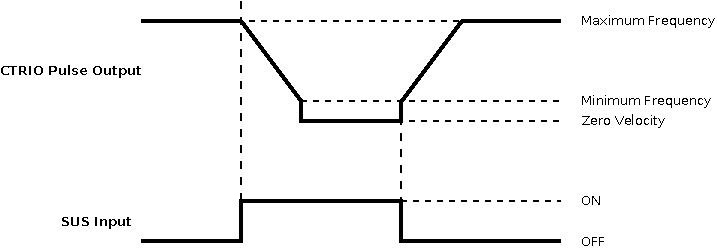
Status Display:
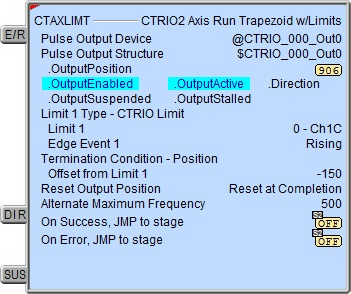
The status display of the instruction shows Values: .OutputPosition, Termination Condition - Position Offset from Limit 1 (if configured), Alternate Maximum Frequency (if configured), and Termination Condition - Limit Creep Frequency (if configured), and the Highlights: .OutputEnabled, .OutputActive, .Direction, .OutputSuspended, and .OutputStalled bits.
The red triangle in the upper left corner of the status display indicates this is a Fully Asynchronous instruction.
CTRIO2 Structure Field Care-Abouts:
The following is a list of the"dot" fields of each Pulse Output Structure that are programmatically used with the CTRIO2 Axis Run Trapezoid w/Limits (CTAXLIMT) instruction. To see a complete listing of all CTRIO structures and members, go to the Project Browser --> Configuration --> Memory --> I/O --> Specialty.
COLOR KEY
Blue: CTRIO2 Input
Maroon: CTRIO2 Output
Black: CTRIO2 Module
Silver: Not used for this instruction
Note: The red "x" is the digit 0, 1, 2, or 3.
NOTES:
(1)This structure member only available for CTRIO2 (not CTRIO). For CTRIO this remains zero.
See Also:
CTRIO2 Axis Run Dynamic Position Mode
CTRIO2 Axis Run Dynamic Velocity Mode
CTRIO2 Axis Run Trapezoid w/ Limits
Example 1 of 2:
Description of a Typical CTRIO2 Axis Run Trapezoid w/Limits (CTAXLIMT) Stage Diagram:
This is a stage diagram of a simple sequence control that would use a stepper motor to move to a position.
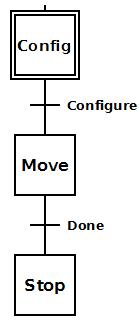
Initially the Config stage waits for Configure to come ON. When it does the CTRIO2 axis is defined and the process transitions to the Move stage.
The Move stage remains enabled until the limit defined by the CTAXLIMT is reached. When it is reached transition is made to the Stop stage.
The Stop stage simply exits the Program code block.
Description of a Typical CTRIO2 Axis Run Trapezoid w/Limits (CTAXLIMT) Stage Ladder:
This is the ladder equivalent of the above stage diagram that uses the CTAXLIMT instruction to move to a position.
This example presupposes the existence of the following System Configuration in the CTRIO2 (PLC --> System Configuration --> Module Configuration(s) --> CTRIO_000 -->):
-
Configure I/O --> Channel 1 --> C --> Limit Out 0
-
Configure I/O --> Outputs --> Out0 --> Pulse (Step/Dir) or Pulse (CW/CCW).
-
A normally OFF limit switch is wired to CTRIO2's Channel 1 Input C.
-
A stepper motor is wired to CTRIO2's Output 0 and Output 1.
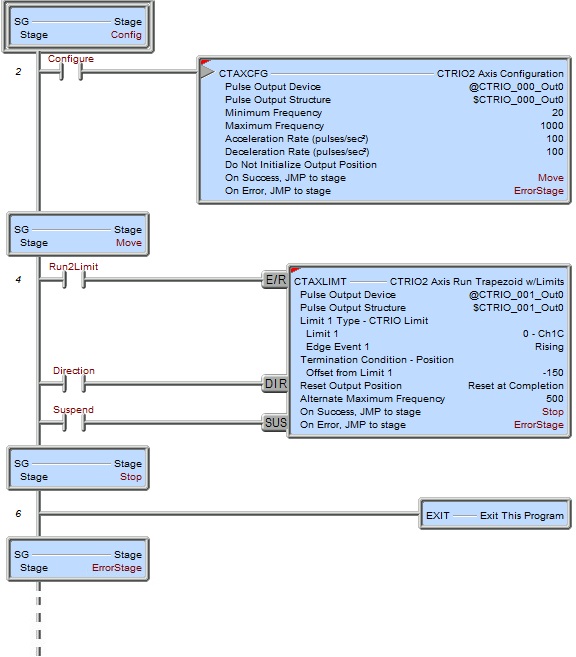
Config is the initial stage and waits for the input Configure bit to come ON. When it does the CTRIO2 axis is configured using the CTAXCFG instruction. If there is an error then transition is made to the ErrorStage stage where ladder logic should exist (not shown here) that would properly handle the error (e.g. to process the $CTRIO_000.ErrorCode value). If the configuration was successful, then transition is made to the Move stage. Since the CTAXCFG is configured to Do Not Initialize Output Position then $CTRIO_000_Out0.OutputPosition is not zeroed.
Move is the main CTAXLIMT instruction stage and will remain enabled for the move. When Run2Limit comes ON it causes the following to happen:
-
If there is an error then the transition is immediately made to the ErrorStage stage.
-
If there is no error then the CTRIO2 Pulse Output is enabled ($CTRIO_000_Out0.OutputEnabled = ON).
-
The CTRIO2 Pulse Output Device is temporarily reconfigured to use an Alternate Maximum Frequency of 500 instead of the 1000 that was initially set by the CTAXCFG instruction.
-
The CTRIO2 Pulse Output accelerates at the Acceleration Rate (configured by the CTAXCFG instruction) in the clockwise direction (if the Direction bit is OFF) or counter-clockwise direction (if the Direction bit is ON) toward the Limit 1 switch at the Alternate Maximum Frequency of 500.
-
When the Limit 1 switch is reached (transitions from OFF to ON on the CTRIO2's Channel 1 Input C; i.e. $CTRIO_000.Ch1C = ON) the Pulse Output Device will decelerate at the Deceleration Rate defined by the CTAXCFG instruction and accelerate using the Acceleration Rate in the counter-clockwise direction (because the Offset from Limit 1 is configured as a negative number -150) defined by the CTAXCFG instruction to the Alternate Maximum Frequency of 500 until the position is reached that is -150 pulses below the Limit 1.
-
When this position is reached the output position is reset ($CTRIO_000_Out0.OutputPosition = 0) because the Reset Output Position parameter is configured as Reset at Completion.
-
The CTAXLIMT, having successfully completed will disable the CTRIO2 Pulse Output ($CTRIO_000_Out0.OutputEnabled = OFF) and jump to the Stop stage.
If during the execution of this move, the Suspend bit comes ON then the CTRIO2 output will decelerate to zero. When Suspend bit goes back OFF it will accelerate back to the Alternate Maximum Frequency.
The Stop stage exits this Program code block.
Example 2 of 2:
